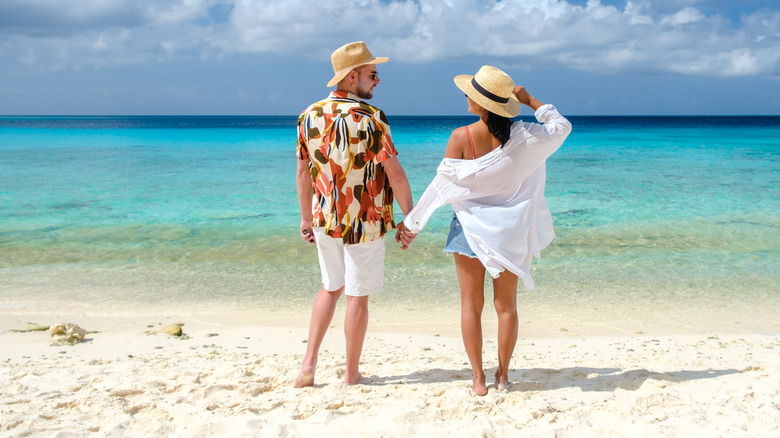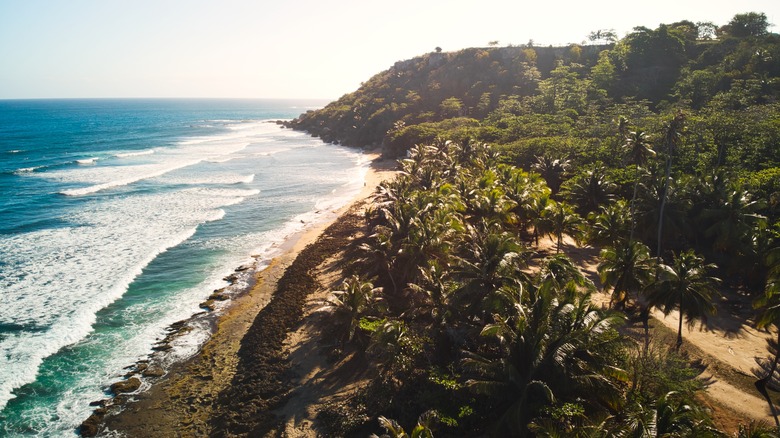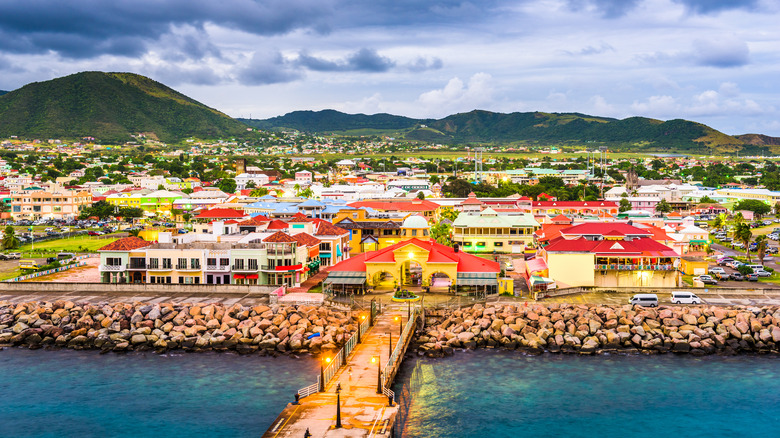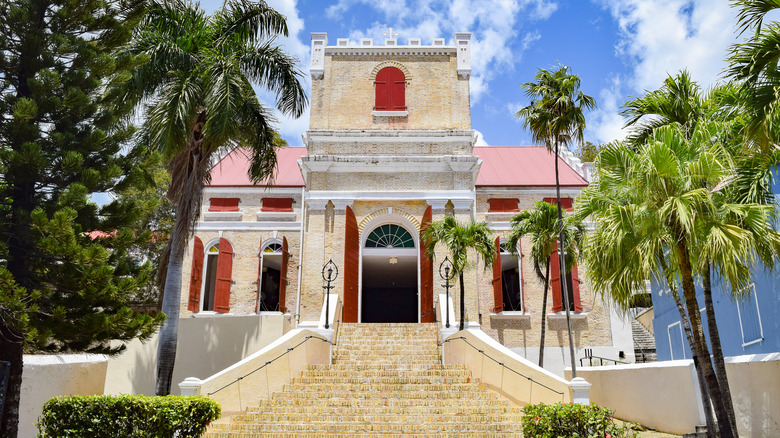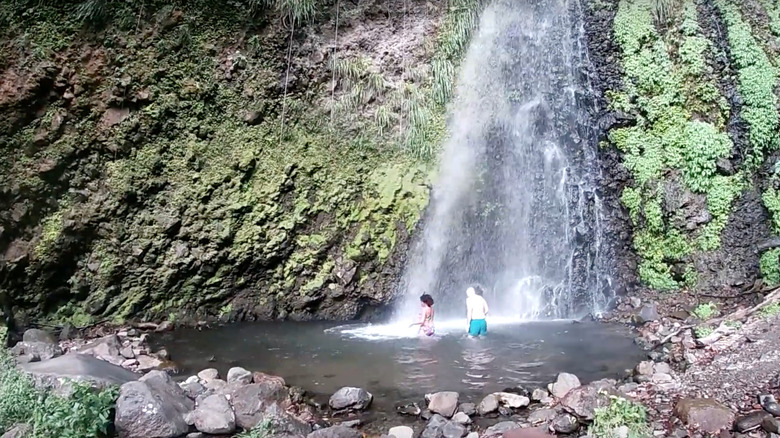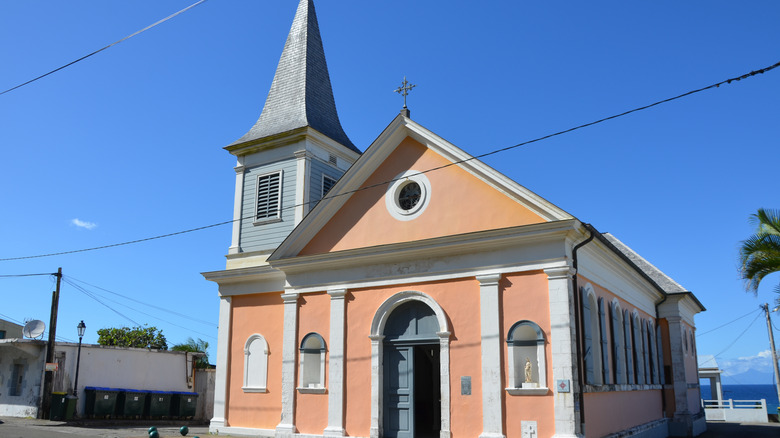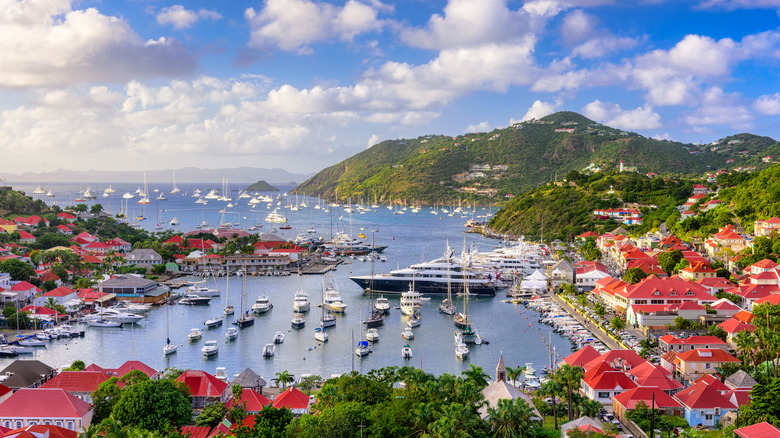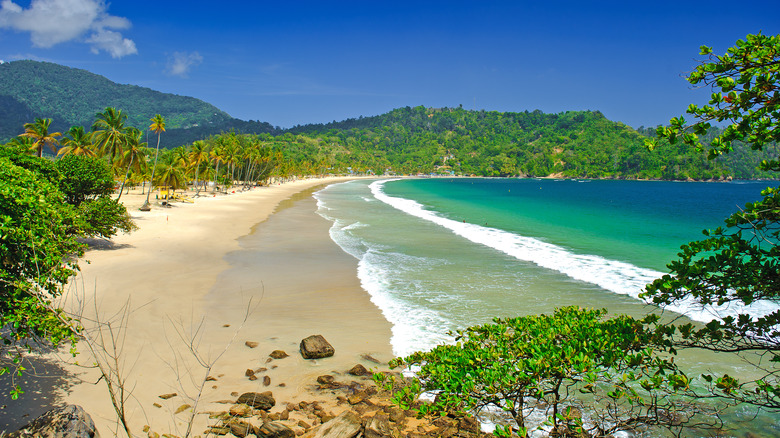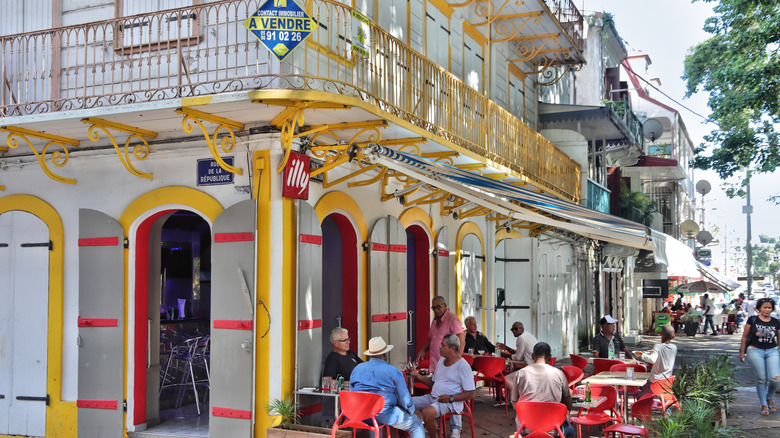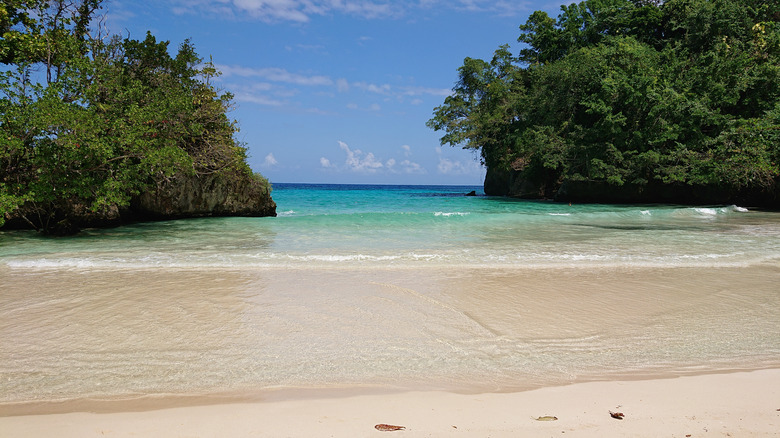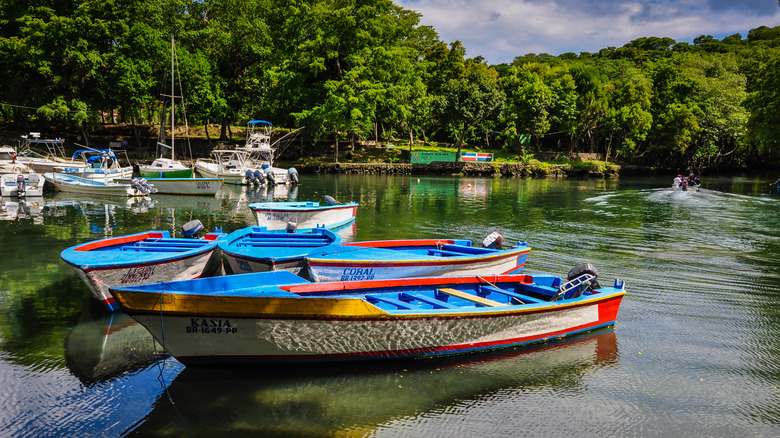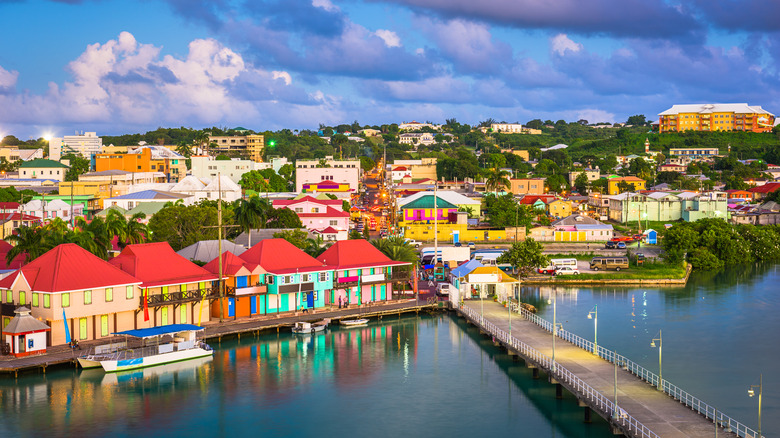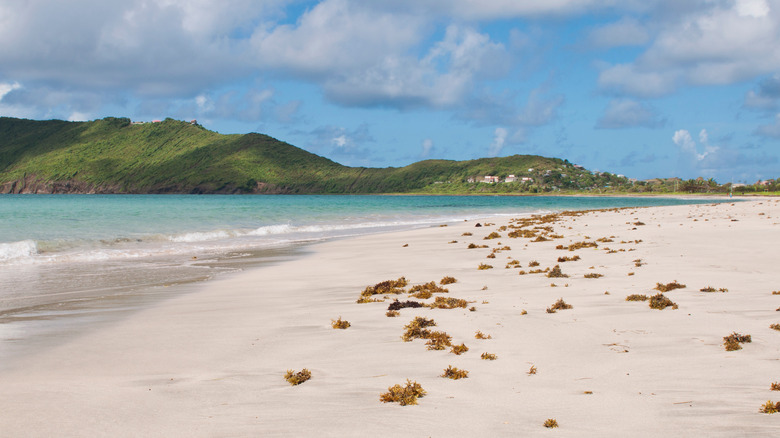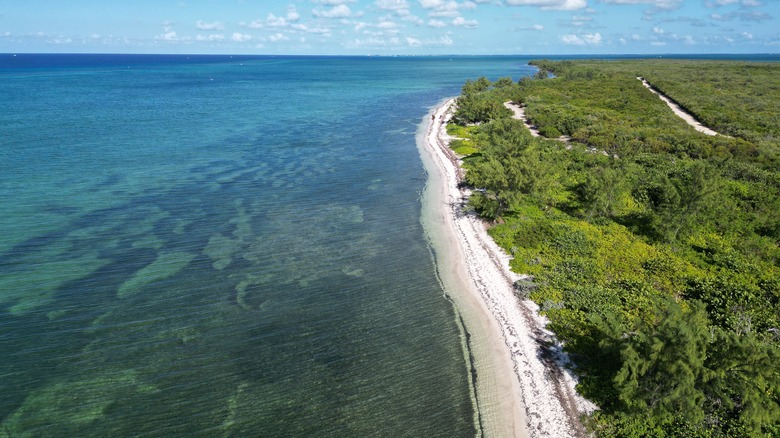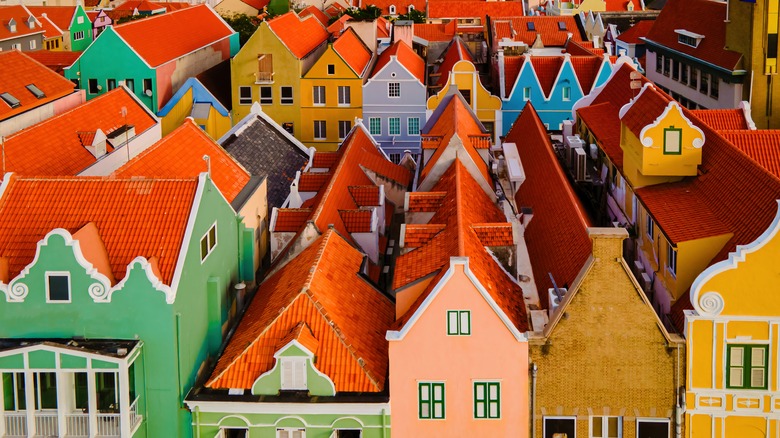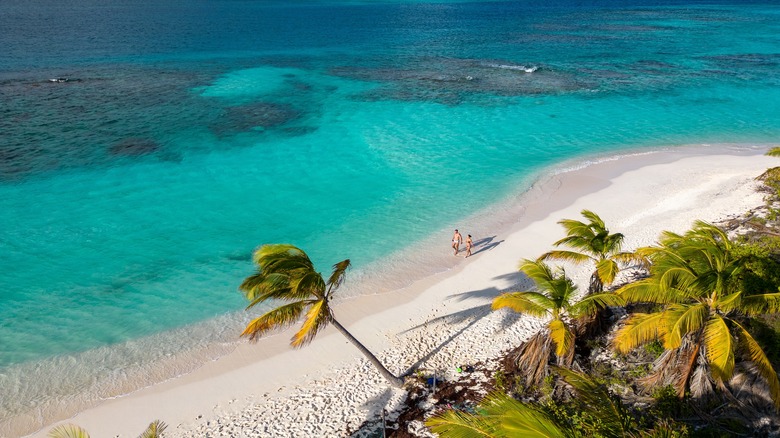Caribbean Tourist Destinations To Have On Your Radar, According To Travelers
A sea between the Atlantic Ocean and North, Central, and South America, the Caribbean has long lured travelers in search of some tropical paradise. It's easy to see why this region attracts so many people; after all, it's populated by islands with palm trees whose leaves crackle together in the wind and water that takes your breath away.
The area boasts vibrant cultures as rich and varied as the isles themselves, resorts with overwater bungalows, and beaches that most visitors would, given the choice, never leave. Millions of tourists visit the Caribbean each year (per Caribbean Tourism Organization), and the 700-plus islands that make it up welcome all sorts — from solo travelers to groups that charter boats for weeks of glorious, sun-kissed island hopping.
Charged with impressive attributes and sizeable tourist numbers, the Caribbean is home to destinations that need no introduction, like San Juan or Ocho Rios. For each of these tried-and-tested locations, though, many more go unnoticed, but that should be very much on your radar. Using experiences from our travels and consulting numerous travel blogs, we've put together some of the top picks.
Aguadilla, Puerto Rico
San Juan is a reliable draw for U.S. tourists who want a quick hop to see some pretty Spanish colonial architecture. But Aguadilla, a town on the northwest of Puerto Rico's main island, has a more relaxed vibe than San Juan and also promises some excellent surfing. Better yet, direct flights to the city from Florida and New York exist. The town itself has much to lure travelers.
El Museo de Arte de Aguadilla y El Caribe showcases, as its name suggests, artwork from residents, students, and other artists on the island. It opened in 1980, and a beautiful old colonial building with a sunny yellow exterior and attractive iron balconies acts as its home.
Are you interested in history? The Ruinas del Faro Punta Borinquen served as a lighthouse that guided ships away from the shore before a tsunami damaged it more than a century ago — its haunting ruins remind of the island's link to the sea. Meanwhile, surfers will likely know of the conditions around Aguadilla thanks to several excellent breaks, including Crash Boat Beach, one of Puerto Rico's best beaches (there's also good snorkeling by the pier), Wishing Well, and Surfer's Beach.
Basseterre, St. Kitts
Basseterre, the capital of St. Kitts (an island shaped like a tadpole), was established in the 1620s. Visitors will find buildings and planning that recall the city of London, with a main roadway called the Circus (it was fashioned after Piccadilly Circus in the English capital) and churches that could easily appear in old Britannia. In the heart of town, visitors will discover the National Museum. Set within a former government building, it offers a great primer on the history and culture of the island.
Birders will enjoy spotting a good variety of seabirds down by the harbor. An easy trip from Basseterre, South Friars Bay sits on a skinny strip of land on the island's Caribbean Sea side, so expect clear and calm water that provides some fabulous snorkeling. There's more outdoor exploration close to the capital at Brimstone Hill Fortress National Park, a Unesco World Heritage site. A military outpost with a troubled history (it was constructed by enslaved people who were brought over from Africa), it is well-preserved and has stunning views of the coastline from its elevated location.
Charlotte Amalie, St. John
The main town of this U.S. Virgin Island has some hypnotic colonial architecture, which will be evident to any visitor who takes some time to walk the streets. One of the most rewarding spots is St. Thomas Reform Church, originally called the Dutch Reformed Church when it was established in 1660. Several structures were built in this location, each succeeding the previous one after a fire, though the current revival-style building, with imposing columns that make it seem like a shrine from Roman times, dates to the 1840s.
You'll also find Blackbeard's Castle in Charlotte Amalie. While it remains closed following damage from a hurricane in 2017, the grounds are open to wander, and visitors can enjoy great island views from the hilltop perch. The walk to get there, up 99 steps that pass through pretty terraced gardens and past many fountains, is a treat in itself. For a vista that will blow you away, take the Skyride to Paradise Point, and you'll see the full breadth of St. Thomas harbor unfurl below.
Chateaubelair, St. Vincent
La Soufrière is an active volcano on the northern portion of the island of St. Vincent, the main isle of the archipelago of St. Vincent and the Grenadines. It last erupted at the end of 2020, with activity pushing into 2021, which goes some way to explaining the origins of the island, where volcanic rock makes up the entire landmass. There has been no activity at the volcano for a few years, but the black sand beach at this small village on the west coast serves as a reminder of the genesis of the island.
Chateaubelair sounds like it could be some tiny Los Angeles district, but it is, in fact, the antithesis of glitz and glamor. Travelers to this slice of serenity will find tranquil water with forested headlands at either end, ensuring no large waves roll in. Palm trees provide good coverage from the sun, and as beachgoers watch fishermen bringing in their daily haul, they might enjoy that feeling of total escape. Near the village, Dark View Falls, a couple of cascades set inside a rainforest, is beautiful to see and even better to bathe under.
Grand'Rivière, Martinique
Oozing with charm, this small village in the north of the French-Caribbean island Martinique promises views of Dominica in the distance. The sleepy fishing hamlet sits beneath the towering Mount Pelee, between a river and canal, wrapping around a curling cove with vertiginous cliffs at one end. In town, the Church of St. Catherine is one of the most appealing buildings, painted in bright sunflower yellow, with a slender bell tower and epic water views. For a more elevated vista, travelers can climb up the hill to the Virgin of the Sailors statue, from where the town, fishing boats bobbing in the harbor, and the Atlantic and Caribbean appear as if on exhibition for all to see.
The greenery in Grand'Rivière is breathtaking, and from interior explorations to gripping coastal walks, the village is the perfect base. Visitors will also enjoy the outstanding local cuisine, which leans heavily on fresh seafood. The Creole dishes at Tante Arlette restaurant include acris de titiris (a tiny regional fish and a village specialty), crayfish, crabs, and lobster.
Gustavia, St. Barts
Gustavia, the main port of St. Barts, is filled with historic buildings and has a lively harbor. The town's setting is primed for taking photos, with scores of red-tile-roof buildings huddled around the compact waterfront and a finger of land on the western side reaching out into the Caribbean Sea. The cove is natural, which is why it became an obvious choice for a port. The town swapped administrations in the 1700s between France and Sweden — its name derives from King Gustav III, a former Swedish royal. The French got the island back in 1877, and that historical chapter of sovereign flux is reflected in some of the buildings.
Tourists will find Fort Karl and the Swedish Fort of Gustav III in Gustavia, both built during Swedish rule, with the former offering spectacular views of Shell Beach. The church Notre-Dame de L'Assomption de Lorient was constructed and rebuilt following fires and damage, and today has a bell that was cast in France. Sitting by the harbor with a coffee and croissant and watching the boats bob in the breeze is an enjoyable pastime.
Maracas Bay, Trinidad
After Trinidad's annual carnival, a riotous explosion of color, sound, outrageous costumes, and unrelenting, pulsing bonhomie and cheer, Trinis will descend on Maracas Bay to unwind and catch a breath. This decompression phase has become a rite of passage, a sort of chill social gathering after the intense social gathering that just occurred, but Maracas Bay is worth a visit at any time of year. The drive northeast from Port of Spain, the capital of Trinidad and Tobago, is an adventure to remember, climbing and descending through mountainous rainforests with hairpin curves and howler and capuchin monkeys prowling the road.
By the end of the drive, the acrid smell of burning brake pads wafts through the air, and the sweeping beach of Maracas Bay presents itself. Curling more than a mile from one end to the other, Maracas Bay is where Trinidadians come to lime (chill out). You see them play in the surf, laze on the beach to the tune of soca and calypso, or chow down on the local specialty dish, bake and shark, sold in huts by vendors that each pride themselves on their unique hot sauce.
Marigot, St. Martin
The island of St. Martin has two different personalities. The French side, called St. Martin, is home to boulangeries and expats that have fled the cold winters of France for some sun and sea, while on the south of the island, the Dutch half of Sint Maarten is home to the airport. Travelers can indulge in a little slice of a "la belle vie" while admiring beautifully preserved 19th-century homes in the main town on the French portion, Marigot.
Stroll along Rue de la République, and you'll notice houses with sturdy bases of stone and mortar, with timber prevalent above. Balconies on the upper floor are ornate, sporting fine railings and gingerbread trim. About 10,000 residents live in Marigot, and the town has a seductive pull, from the old homes to churches from the 1800s. On every day but Sunday, the waterfront market is a smorgasbord of food, fruit, vegetables, spices, crafts, and souvenirs. For the best view of the town and harbor, tourists can head up to Fort Louis, constructed in the 1780s, where old walls and cannons hint at its storied past.
Pointe-à-Pitre, Guadeloupe
The French-Caribbean islands of Guadeloupe might not have the name recognition with U.S. travelers of destinations like the Dominican Republic, Jamaica, or Grand Cayman, but that does this gem a disservice. There is plenty to enjoy there — and direct flights from the United States — from excellent food to great arts, and the main town of Pointe-à-Pitre, located on the island of Grande-Terre, distills the island's greatest hits. The architecture might make visitors think that they have arrived in New Orleans; with wraparound iron balconies and bright colors, the homes recall that Louisiana stalwart.
Travelers will find smooth buildings with sensuous Art Deco lines and even more contemporary sites elsewhere. One example of the latter is the Memorial ACTe, where the modern mesh lattice frame on its facade, built where a former sugar factory once stood, fronts a museum that looks at the harrowing past of slavery and its role on the island. For something a little less profound, order a local rum at a bar overlooking the harbor or get in some shopping at the Marché Saint-Antoine.
Port Antonio, Jamaica
Forget busy Montego Bay and its quieter sibling, Ocho Rios, in Jamaica's west, and head to this relaxed town in the east of the island, in the parish of Portland. Port Antonio was once where high-flying creative types would come for a vacation. The jagged coastline, gorgeous beaches, and a sense of tranquility in tucked-away bays and coves drew luminaries like Errol Flynn and Noel Coward.
The town feels more authentic than touristy MoBay, and this part of Jamaica is where you can find some of the country's finest swimming spots. Among them is Frenchman's Cove, a resort and beach where a river flows into the sea, and the stunning turquoise water is hemmed in by forested headlands, making the beach feel like a remote, hidden realm at the edge of the earth.
For another striking bit of nature, head to the Blue Hole, also known as the Blue Lagoon. A dip in this shimmering body of water, with colors that can change from emerald to turquoise to sapphire, depending on the angle of the sun's rays, will make you feel like you're bathing in heavenly nectar.
Rio San Juan, Dominican Republic
The Dominican Republic has a well-developed tourism product and strong links to the United States — not least thanks to its large diaspora — and welcomes millions of Americans each year (via Dominican Today). Many people head to the large resort enclaves like Punta Cana, where banks of all-inclusive offerings line the waterfront up the eastern coast. But Rio San Juan, a quiet village on the north coast most easily reached from Puerto Plata's airport, offers an altogether different experience.
A visit to Rio San Juan is a study in quietude. In this relaxed, small settlement, life feels like it hasn't changed much in decades, and where hotels tend to be manageable and locally run, not pieces of a giant, international chain. And yet, there are world-class beaches nearby, including Playa Grande (home to the über-luxe Amanera resort) and Playa Caléton. The shore in Rio San Juan isn't ideal for lounging, with black outcroppings of volcanic rock zig-zagging along the coast. You won't want to miss Laguna Gri-Gri, a thicket of mangroves that acts as a bird sanctuary (especially active at sunset) that is best explored by boat.
St. John's, Antigua
The capital of Antigua and Barbuda islands, St John's, supplies incredible historic buildings and vibrant markets. Stopping by the Museum of Antigua and Barbuda, housed in a former courthouse from the 1750s (perhaps the town's oldest building), is a good way to start your visit. It offers a fascinating look into the past of this twin-island nation through the lenses of geology, crafts, engineering, and the workplace. History is also the lure at Fort James, on the edge of the town's harbor, where many cannons still endure, allowing visitors to get a snappy visual image of the military set-up from years past.
For an island that prides itself on its vast number of beaches — some estimates point to Antigua having 365 such destinations, one for every day of the year — Dickenson Bay, slightly to the north of St. John's, is one of the finest. Visitors to the beach will find glittering white sand, calm turquoise water, and plenty of options for eating and water sports. When the day ends, St. John's also promises a healthy dose of nightlife, with beachfront bars drawing many a roving traveler.
Vieux Fort, St. Lucia
Nature lovers often find themselves drawn to the island of St. Lucia, perhaps, quite simply, by its landscape. The twin peaks of the Pitons, a pair of dormant volcanic towers on the southwest coast covered by dense forests, call out to outdoors types. Visitors can take a boat to marvel at them from afar or attack them on foot, with hikes in their lower environs. But nature lovers can also find much to enjoy at Vieux Fort, the second-largest town on the island after Castries. Vieux Fort lies just south of the international airport, making it a convenient destination, and is part of a peninsula that looks a little like a boot.
On the east of town, Anse des Sables beach extends for more than one mile, and it's a striking spot, cupped by cliffs and protected by a reef. It manages to catch some winds, making it a popular hangout for windsurfers and kite-boarders. Moule-a-Chique is a site not to miss at the island's southern tip. The lighthouse, more than 700 feet above sea level, is over a century old and is one of the highest lighthouses in the world. Looking down at where the Caribbean and Atlantic meet and north up the coastline, the views are heart-stopping.
West Bay, Grand Cayman
The largest of the trio of Cayman Islands, Grand Cayman gets oodles of cruise passengers, has tons of accommodations, and is where travelers can encounter scores of stingrays at a sandbar far off the north coast at the aptly named Stingray City. The main draw is Seven Mile Beach, a seemingly endless slash of sand on the west coast, where luxe resorts dot the shore. And what a shore it is, with soft sand and stunningly clear and blissfully calm turquoise water that begs to be jumped into.
Much of Seven Mile Beach is geared toward the tourist masses, but at its top end, West Bay is a nub of land that looks like a turkey's head. There are fabulous beaches in West Bay, and it's a tranquil alternative to the commercial development of the lower reaches of Seven Mile Beach and George Town, the islands' capital. West Bay may not have the hotel density of other parts of the island, but tourists will find many rental properties. Lovers of sea creatures can also snorkel with the shelled marine creature in a lagoon at the Cayman Turtle Centre.
Willemstad, Curaçao
The multicolored buildings by the waterfront in the capital city of Curaçao are pure confection — and they make for astonishing photo subjects, so bright and vibrant under a clear blue sky — but this town also has a more serious side, with some amazing art and museums. Known as Punda Willemstad, the streets around the waterfront are closed to traffic, making them a stress-free place for a stroll and packed with stores, restaurants, and cafes. The buildings showcase Dutch colonial architecture, from the whitewashed trim to the curved gables, and hint at the island's past as a Dutch colony.
Willemstad also has a strong artistic tradition, with many galleries peppered around its alleys, like Landhuis Bloemhof, a stronghold for visual art that sits within a mansion from the 1730s. If there is one institution that can't be missed, it would be Museum Kurá Hulanda. Located in the heart of the harbor, it's a sobering, unflinching look at the African slave trade and the way its influence has shaped modern-day Curaçao.
How we chose the Caribbean tourist destinations
The Caribbean has a seductive quality with some of the most startling beaches and waters on the planet. But some parts have been overdeveloped, crushed, and cursed by tourism. To put together these places off the beaten track, we relied, first and foremost, on our extensive travels around the area, throwing in some personal favorites. We bolstered those choices with intel from travel blogs to offer a robust geographical spread throughout the islands, from north to south.
